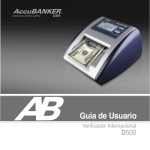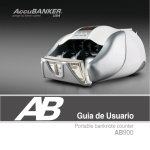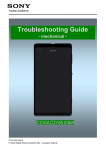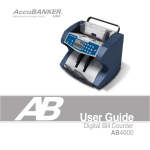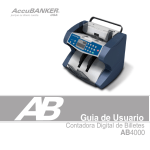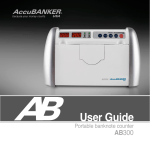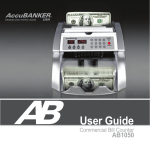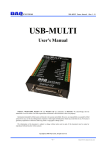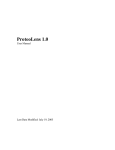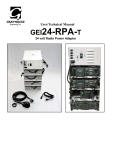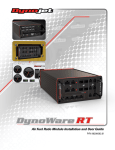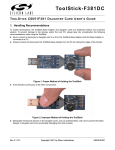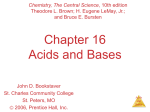Download MODEL 6500 SYSTEM II Service Manual 6500
Transcript
Operation and Maintenance Instructions With Illustrated Parts List For AIRBRASIVE® UNIT MODEL 6500 SYSTEM II Service Manual 6500 S.S. White Technologies 151 Old New Brunswick Road Piscataway, NJ 08854 1-800-779-4483 (REVISED 2-18-04,) Section I Introduction and Description 1-1 Introduction: 1-1.1 Scope. This technical manual contains operation and service instructions and illustrated parts list for AirBrasive Unit Model 6500 manufactured by S.S. White Technologies in Piscataway, New Jersey. 1-1.2 Characteristics. This Unit is an AirBrasive Jet Machining System. This device will cut, drill, clean, etch, and deburr materials. Finely graded abrasive particles are propelled at high velocity through precision nozzles to strike the work area. The 6500 does not need electricity to run. The powder flow is caused by vibration generated by a “pneumatic vibrator” using compressed air. The 6500 is also equipped with a quick powder change feature. The Unit is designed specifically to use a variety of nozzles and specially prepared Airbrasive powders produced and distributed by S.S. White Technologies. 1-1.3 Controlling factors. The controlling factors of the Unit are listed in Table 1-1. Air supply requirements Power requirements Weight Dimensions (inches) Air Supply 50 to 140 PSIG None 18 pounds Height 13” (33cm) Width 9.65” (24.5cm) Depth 7.5” (19cm) 3.0 CFM (1.4 L/Sec.) Powder Capacity 2 Lbs. (0.9 kg) Table 1-1 1-1.3 Equipment Supplied. Table1-2 contains a list of all standard equipment supplied with the unit and also lists optional equipment available from S.S. White Technologies. 1-1.4 Accessories. In addition to the equipment supplied, the Unit requires a dust collection system and an external source of clean air, dry compressed air, carbon dioxide, or nitrogen together with a single stage pressure regulator. The normal air supply to the Unit should be about 70 PSIG, but can range from a minimum of 50 PSIG to a maximum of 100 PSIG. - - 2 Part Number Standard Equipment AU601 AH101x AR105 AN106 AN119 AN124 AP101 AP105 Optional Equipment AK104 Description Quantity AirBrasive Model 6500 Nozzle & Handpiece Assembly Foot Switch Nozzle (Straight, Round, .032” I.D.) Nozzle (Straight, Round, .018” I.D.) Nozzle (Straight, Rectangular, .006”x.060”) AccuBRADE 27-Aluminum Oxide AccuBRADE 50-Aluminum Oxide 1 1 1 1 1 1 Spare Parts Kit 1 1 1 Table 1-2 WARNING: Do Not Use Oxygen as an air supply for the unit! An explosion could occur. IMPORTANT: The Unit requires a suitable dust-collecting hood placed near the unit to collect used powder. S.S. White Technologies offers dust collectors and work chambers for this purpose (See Section 2-2.2). 1-2. Description. 1-2.1 The front panel of the unit includes an on/off switch, “on” indicator, air pressure regulator, pressure gage, powder flow control, handpiece, and an on/off foot switch. The black tubing extending from the rear of the machine is for an output from an external air supply. The component of the unit provide a controlled mixture of powder in a dry air stream and delivers this mixture to a tungsten carbide nozzle tip in the handpiece. - - 3 Section II Preparation for Use 2-1 Initial Procedure. 2-1.1 Unpacking. The Unit and all accessory equipment are shipped in a single container. As the unit is unpacked, check all the items against the list of contents packed and with the items listed in Table1-2. Do not discard any packing material until all deliverable items have been checked against the list of contents. NOTE: Refer to the illustrations and parts lists in Section VII as required to identify parts and components called out in these procedures. 2-2 Supply Requirements. 2-2.1 Air Supply Requirements. Minimum - 40 psig (2.7 bar). Maximum - 140 psig (9.5 bar). To utilize the Unit to maximum advantage, an air supply pressure of 85 psig (5.8 bar) should be available. Cutting and cleaning rates increase as the pressure of the Micro-Blast nozzle is increased. This pressure can be adjusted with the panel-mounted control from 10 psig (0.7 bar) up to the limit of the air supply. The air supply must be clean and dry! The S.S. WHITE Air/Oil filter (part number AA111) will satisfy this requirement. NOTE: Operating your Micro-Blast 6500 System over 85 psig can cause excessive wear of parts, increasing replacement rates. 2-2.2 Dust Collection. A dust collector is required to keep operator exposure to dusts below the permissible exposure limits regulated by OSHA (Occupational Safety and Health Association) and ACGIH (American Conference of Government Industrial Hygienists). S.S. White Technologies has available a dust collecting system. Consult S.S. White for the correct type of dust collection system to suit your needs. 2-3 Installation. The work chamber and the Unit should be situated either next to each other or with the Unit on top of the work chamber. - - 4 IMPORTANT: Follow these instructions every time you need to open the front panel. 2-3.1 filling the powder chamber. Observe the following procedures when filling the powder chamber of the unit: 1. Place the POWER switch of the unit to the OFF position. 2. Open the door of the powder section by pulling the top of the door toward you and down until it stops. This action exposes the powder chamber and quick release clamp. 3. Grasp the powder chamber in one hand and open the clamp by pulling the handle toward you with the other hand. 4. Loosen clamp and remove the powder chamber. 5. Fill the powder chamber with the desired amount of powder. DO NOT OVERFILL!!! NOTE: Make certain that no lint, dirt, or other foreign substances enter the mixing chamber. They can clog the mixing chamber orifice plate. 6. Clean the sealing surface of the Powder Chamber. 7. Return the chamber to the unit. Make sure the chamber is correctly seated. If clamp is difficult to close, open it and re-seat chamber. Secure the clamp and CLOSE THE DOOR COMPLETELY! 2-3.2 Air Filter Connection. The air supply hose, 1/4” (6.4mm) diameter X 10’ (3m) long, enters into the rear of the unit (see figure 1). A 1/4” NPT 1/8” hose connector is provided to connect the hose to the air filter (Part # AA111). Install the air filter at a convenient point and connect to the compressed air (or gas) supply. CAUTION: Does Not Use Oxygen, Hydrogen, or any combustible gas as a propellant, an explosion or fire could result. - - 5 2-3.3 Ground Wire Connection. An insulated wire, with #10 terminals at the ends, is supplied in order to ground unit against any static charges generated by the powder flowing through the hoses in the unit. A grounding terminal is located on the rear of the unit adjacent to the air supply hose. To connect the wire, proceed as follows: 1. Connect the ground wire to this terminal with the hardware provided. 2. Connect the other end of the wire to the thumbscrew that secures the lamp housing to the work chamber or to any other convenient earth/ground point. IMPORTANT: Failure to connect the grounding wire can result in the operator being subjected to static electricity shocks when using the system. 2-3.4 Dust Collector Installation. Connect the dust collector to the work chamber with the flexible tube and metal clamps provided. IMPORTANT: The Unit requires a dust-collecting hood placed near the unit to collect powder. S.S. White Technologies offers dust collectors and exhaust chambers. - - 6 Section III Operation Instructions 3-1 Operating Instructions. To operate the AirBrasive Unit, proceed as follows (Refer to Figure 3-1 for an explanation of all the controls, indicators, and connectors on the unit): 1. Fill the powder supply chamber (See Section 2-3.1). 2. Turn on the dust collector. 3. Install nozzle onto the handpiece and place it into the work chamber. 4. Turn the On/Off switch to “On”. 5. The indicator turns red when the powder chamber is pressurized. Look at the pressure gauge and adjust the air pressure. For most applications is 65 psig (4.4 bar). 6. Adjust the “powder flow lever” to the middle of the flow range. 7. Direct the nozzle at the workpiece and fully depress the foot-switch. IMPORTANT: The foot-switch must be fully depressed for the unit to function properly. 8. Adjust the powder flow rate, operating pressure, and/or nozzle tip distance as necessary, to accomplish the desired result. IMPORTANT: This unit is equipped with safety interlocks. The powder section cannot be pressurized unless the door is FULLY CLOSED. Also, the door cannot be opened unless the unit is turned “OFF”. DO NOT FORCE THE DOOR! This may damage the unit. If the door will not easily open with unit turned “off”, consult the “Trouble Shooting” chart. - - 7 Item Panel Title or Name Function or Operation 1 2 Indicates operating pressure Adjusts operating pressure 3 4 Air pressure gauge Main air pressure regulator control knob Red indicator Power ON/OFF switch 5 Powder flow lever 6 Handpiece Indicated pneumatic power to unit In ON position provides pneumatic power to unit As lever is pushed to the right, powder flow increases into the air stream. Holds the nozzle through which powder flows Operating Controls, Indicators, and Connectors Table 3-1 3-2 Operating Procedures. 3-2.1 General Information. The following paragraphs describe the AirBrasive Jet Machine cutting process, the value and use of cutting speed, the selection and purpose of the amount of powder flow to be used, and the selection of air pressure. 3-2.2 The AirBrasive Jet Machine Cutting Process. The unit performs a cutting action by the impact of sharp-edged powder particles on a hard surface. S.S. White Airbrasive powders are recommended. The use of other commercial powders can cause excessive maintenance repairs. The powder stream, exits the nozzle about .018” in diameter for approximately 1/16” away from the tip. Then the spray pattern spreads out in a conical shape with a total included angle of 7 degrees. To obtain sharp definition, as in precision cutting, the Nozzle Tip Distance should be kept to a minimum, approximately 1/32”. 3-2.3 Cutting Speed. Adjusting the powder flow may vary speed of cutting. Further variation may be obtained by using different pressure settings, powders, and special types of nozzles. 3-2.4 Adjustment of Powder Flow. When the foot switch is depressed a mixture of powder and air will be discharged from the handpiece nozzle. The POWDER FLOW lever controls this mixture. 3-3.5 Pressure behind the Nozzle. Pressure behind the nozzle (with powder flowing) of approximately 65 PSIG has been found to be satisfactory. - - 8 Section IV Theory of Operation 4-1 Theory of Operation. Proper operational and maintenance care will assure a long service life. The Unit’s pneumatic diagram has been provided to aid in the trouble shooting (See Figure 4). 4-2 Pneumatic. 4-2.1 Vibrator. The vibration mechanism is pneumatic. Adjustment for the internal regulator in located on the back of the unit (See Figure 1 ). 4-2.2 Pinch Valve Regulator. The Pinch Valve Regulator is factory set. Adjustments can be made at the back of the unit (See Figure 1). 4-2.3 Switch On. The main switch, when turned on, will turn indicator light red and pressurized the unit. 4-2.2 Switch Off. The indicator lamp turns off and the air pressure bleeds off through the nozzle. 4-2.4 Main Air Regulator. The main air regulator controls the pressure of the air supply to the powder chamber and to the handpiece nozzle. Air pressure is indicated on the main gauge on the front panel of the unit. - - 9 SECTION V SERVICE INSTRUCTIONS 5-1 Periodic Inspection. The unit should be inspected periodically for the following conditions: A. Damaged case or cover. B. Frayed or worn hoses. C. Worn nozzle. D. Loose hose connections. E. Worn Pinch Tube F. Air Filter 5-2 Periodic Cleaning. Periodic maintenance is recommended for the unit: 1. Brush or vacuum all dust, dirt, and spilled powder from the interior of the unit. Do not use cleaning fluid on the air or powder hoses. 2. Clean external surface of the unit with a soft lint free cloth moistened with mild cleaning solution. 5-3 Components and Maintenance. 5-3.1 Nozzle and Hose Assembly. Three nozzle assemblies, listed in Table 1-2 are supplied with the unit. Nozzle tips are made carbide and must be handled with care. Nozzle assemblies with tips for special applications are available. 5-3.1.1 Nozzle Assemblies. A fuzzy powder stream, with lack of definition means that the nozzle is worn and should be replaced. To replace, simply unscrew the nozzle assembly from the connector and install a new one. Make sure nozzle assembly is tightened snugly (do not over tighten) and screw threads are not crossed. CAUTION: Nozzles should be stored in a safe place when not in use. 5-3.1.2 Nozzle Clogs. To unclog a nozzle, do the following: 1. Turn the unit off and relieved of air pressure and remove nozzle. 2. Slide POWDER FLOW control lever completely to the left. 3. Turn nozzle around hold tight up against the nozzle connector. 4. Turn unit on and press foot switch to reverse flush the clogged tip. - - 10 5-3.2 Pinch Valve Assembly. With the door open, the air pinch valve assembly is mounted at the top of the unit. Three hoses are connected to it. Two of the hoses are to the pinch valve tube. The other hose, connected to the bottom, is the plunger of the pinch valve assembly. The pinch Valve is Normally Open. 5-3.3 Pinch Tube. Pressing the foot switch opens the air pinch valve tube. With air supply connected, the plunger is up pinching the tube. Pressing the Foot Switch de-energizes the plunger opening the airflow. If the pinch valve tube is always open, permitting powder flow through the pinch valve tube without the foot switch being actuated, proceed as follows: 1. Remove, and disassemble air pinch valve assembly (per Figure 3). Inspect and replace worn or damaged parts. 2. Remove hose connections from base of air pinch valve assembly and check for air pressure from pinch valve regulator. If there is none then, adjust air pinch regulator for proper pressure. If this fails, replace air pinch valve pressure regulator. 5-3.2.3 Pinch Tube Replacements. It is not necessary to remove the pinch valve assembly from the unit to replace this tube. Proceed as follows: 1. Turn machine off. 2. Remove top block from assembly. Pull the old tube off the fittings. Carefully insert new pinch tube into fittings and make certain to align the ends of the tube with the indentations in the bottom block and the tube seams parallel to the side of the block. 3. Carefully replace top block, again making certain that the tube ends align with the indentations in the top block. Secure top block in place with attaching hardware. 5-3.4 Red Indicator The on indicator actuates if the unit has pneumatic power. When the switch is in the ON position the actuator is red. 5-3.5 Main Air Regulator. The main air regulator adjusts pressure of the main air supply within the unit. This regulator is not repairable at field level. Malfunction is not likely, but if rotation of its control knob does not have any effect on air pressure, the part should be replaced. 5-3.9 Throttle Assembly. The throttle assembly meters powder particles into the main air stream and to the handpiece nozzle. 5-3.9.1 Principle of Operation. When the foot switch is pressed, the pinch valve tube opens and air flows into the mixing chamber and out through the fitting on the throttle body. The pneumatic vibrator is energized; powder falls down into the air stream through the throttled orifice. - - 11 Section VI Removals, Replacements, Repairs 6-1 Tools. Following is a list of tools you may need to do any removals, repairs, or replacements: A. Needle nose pliers B. Adjustable wrench C. Allen wrenches: 9/16” & 5/64” D. Flat-head screw driver E. Wrenches: 7/16”. 1/2”, 9/16” F. Philips Head Screw Driver. 6-2 Removal. 6-2.1 Removal Instructions. When working on the Model 6500 always use common sense and good, safe workshop practices. Care should be taken to assure that all removed hoses are marked to provide positive identification during replacement. Use the illustrations in the Appendix during maintenance. CAUTION: Turn off unit and disconnect air supply before working on Unit! 6-3 Replacement. The following Spare Parts Kits should be kept on hand, and replenished as parts are used: Spare Parts Kit Part # Description Qty AR142 AM108 AO103 AO104 AO106 AQ123 AR104X AT118 AQ114X Pinch Tube Spring for Vibrator Assembly O-ring, O.D.-.285; I.D.-.145 O-ring, O.D.-.443; I.D.-.237 O-ring, O.D.-3.637; I.D.-3.359 Nozzle Connector Carbide Fitting for Pinch Valve Hose, Blue Fitting Ass’y 10-32 to .103 Dia. tube Table 4-1 12 1 1 1 2 6 4 25ft 2 - - 12 6-4 General Repairs. The following section is for some general repairs. 6-4.1 Common Problems. 1. O-Rings Replace any O-rings that are misshapen in any way. 2. Wave Spring If the Wave Spring is broken in more than one place it needs to be replaced. 3. Powder If there is any powder in the vibrator race it must be removed. 4. Powder Clogs Do a visual check of the throttle body, and if any powder is present, blow it out. 5. Fittings Fittings from the vibrator body and the throttle body can be removed and replaced. 6-4.2 Disassembling the Powder Chamber. To get inside the throttle body do the following: 1. Turn the Unit “off”. 2. Open the front panel. 3. Remove the black hose and label location, this is the main air supply to the powder chamber. 4. Remove the brown hose and label location from the Vibrator Inlet Air Supply. 5. Unscrew the powder flow lever and remove. 6. Disconnect the blue hose from the Throttle Body to the Pinch Valve Assembly. 7. Remove the three nuts on the top of the Base Plate holding the Shock Mounts of the Powder Chamber Assembly. The Metal Chamber is now disengaged from the Unit. 9. Use the 9/64” Allen wrench to remove the four screws from the Base Plate. Remove the ground wire. 10. Remove the three metal washers connected to the black rubber Shock Mounts. 11. Lift off the Base Plate. 12. Remove the Adjustment Collar from the Throttle Body. 13. Remove the wave spring from the Throttle Body. 14. Unscrew the Brass Throttle Needle Body from the center of the Adjustment Collar. 15. Remove the Steel Ball from the Vibrator Race. 16. Remove the O-ring from the Powder Chamber. 17. Lift the Powder Chamber Orifice out from the Vibrator Body. 6-4.3 Re-assembly - - 13 1. Unscrew the needle 1/2 turn before reassembling. Screw the Brass Throttle Needle into the Adjustment Collar. 2. The brass section of the Throttle Needle must NEVER protrude from the Adjustment Collar. It rotates against the Throttle Body and the Base Plate (Keep it FLUSH). 3. Insert the Wave Spring (lubricate with greese). 4. Insert the Adjustment Collar Assembly into the Throttle Body and insert the Orifice with the “O” Ring into the throttle body. 6. Line up the holes on the powder chamber, Base Plate, and Throttle Body. 7. Replace the four assembly screws. 8. Replace the three washers. 9. Reconnect the brown and black hoses. 10. Reconnect the Powder Chamber Assembly to the door. 11. Reconnect the blue hose to the Pinch Valve Assembly and the Throttle Body. 12. Close the door half way and insert the Powder Flow Lever through the front. Screw it into the Adjustment Collar. 13. Turn Powder Control Lever to minimum position. Turn the Throttle Needle, with an Allen wrench, clockwise until it seats. Then turn it counter-clock wise 15° - 30°. 6-4.6 repairing the O-Ring in Powder Chamber. 6-4.6 1. Release the V-Band Clamp. 2. Pull the Powder Chamber away from the Vibrator Body. 3. Remove the O-Ring from the Vibrator Body and clean remove any powder from the grooves. IMPORTANT: Be careful not to damage the O-Ring. 6-4.7 The Pneumatic Section. To remove the Pneumatic Section from the Unit: - - 14 1. Open door half way. Remove the screw located on the base of the unit perpendicular to panel face. It is directly beneath the on/off switch. 2. Lift the panel up and toward you. The Manifold: • On/off switch. • Pressure indicator. • Pressure Regulator. • Pressure Gauge. • Pinch Valve Regulator. • Air Pilot Valve. 6-5 Service Tips. 6-5.1 Flow Difficulties. Some causes of powder flow difficulties are as follows: 6-5.1 A. Worn or clogged nozzle assemblies. B. Over filled or nearly empty mixing chambers. Note, also, that a slightly heavier flow may be noticeable just after the powder chamber has been filled. C. Reused, contaminated, or improper powders. Use of S.S. White AirBrasive powders is recommended. D. Insufficient nozzle pressure, due to leaks. 6-5.2 Testing for Leaks. Observe the following service tips: 6-5.1.1.1 1. Turn on air pressure until the system is pressurized. Shut off the external air supply valve and watch the AIR PRESSURE gauge. If the pressure drops more than 15 PSIG during the first five minutes then, the system leakage is more than one cubic foot per hour. Check fittings and components for leaks 2. Most leaks can be traced either by ear, touch, or use of soap and water. The presence of powder can indicate a leak. 3. Powder Chamber may require periodic replacement of O-Ring. 4. Immersed nozzle tip in water. Pressurize system with the pinch valve tube closed. Leakage through the pinch valve tube should not exceed three bubbles per second. - - 15 Section VII Illustrated Parts Breakdown 5-1 Introduction. The illustrations or assembly drawings are assigned figure numbers that will serve as a reference when discussed in the manual. - - 16 AirBrasive Powders Name Material Particle Size Part # Size AccuBRADE10 AccuBRADE17 Aluminum Oxide 10 Micron Aluminum Oxide 17 Micron AccuBRADE27 Aluminum Oxide 27 Micron AccuBRADE27 Aluminum Oxide 27 Micron AP107 AP108 AP109 AP131 AP110 AP101 AP121 AP102 AP104 35 lb. 40lb. 35lb. 10 lb. 45 lb. 35lb. 15 lb. 50 lb. 50 lb. AccuBRADE50 Aluminum Oxide 50 Microns AccuCLEAN-50 Sodium Bicarbonate 50 Micron AccuCLEAN-50 50 Micron AccuCUT-50 Sodium Bicarbonate Silicone Carbide AccuPEEN-44 Glass Bead 44 Micron AccMATTE-75 Crushed Glass 75 Micron AP105 AP123 AP106 AP111 AP124 AP112 AP113 AP132 AP114 AP128 AP115 AP116 AP129 AP117 AP118 AP119 35lb. 15 lb. 50 lb. 2.5 lb. 10 lb. 35 lb. 10 lb. 25 lb. 35lb. 10 lb. 45 lb. 35lb. 10 lb. 40 lb. 2.5 lb. 35 lb. Electronics Special Electronics Special 50 Micron Table 5-2 - - 17 - - 18 - - 19 Pinch Valve Assembly - - 20 Cross Section of 6500 Front Panel - - 21 - - 22






















